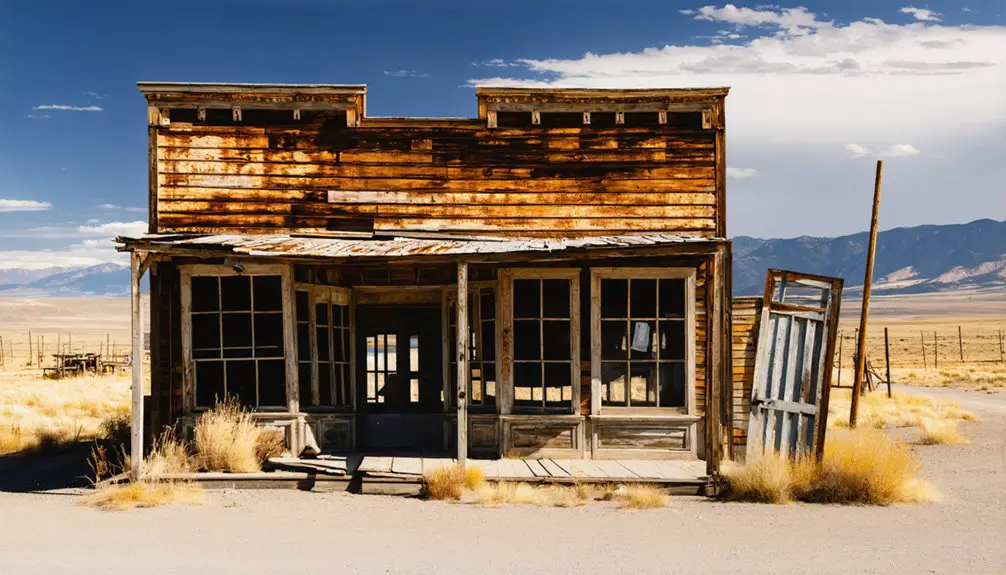You’ll find Red Bluff ghost town in Montana’s Tobacco Root Mountains, where gold fever sparked a thriving frontier settlement in 1864. At its peak, nearly 500 residents called this mining hub home, with twelve saloons, a post office, and two industrial gold mills driving the economy. When the Northern Pacific Railroad bypassed Red Bluff in 1890, the town’s fate was sealed. Today, the haunting ruins of Tanners Hotel and a stone schoolhouse tell tales of Montana’s golden age.
Key Takeaways
- Red Bluff was established in 1864 as a gold mining town in Montana’s Tobacco Root Mountains, reaching a peak population of 500.
- The town featured twelve saloons, a post office, gold mills, and the Tanners Hotel during its prosperous mining heyday.
- Red Bluff declined after being bypassed by the Northern Pacific Railroad in 1890, leading to population loss and business closures.
- By 1901, Red Bluff became a ghost town following the closure of its post office, school, and commercial establishments.
- Today, only ruins of Tanners Hotel, a stone schoolhouse, and the historic Red Bluff-Norris Cemetery remain as tourist attractions.
The Birth of a Mining Frontier Town
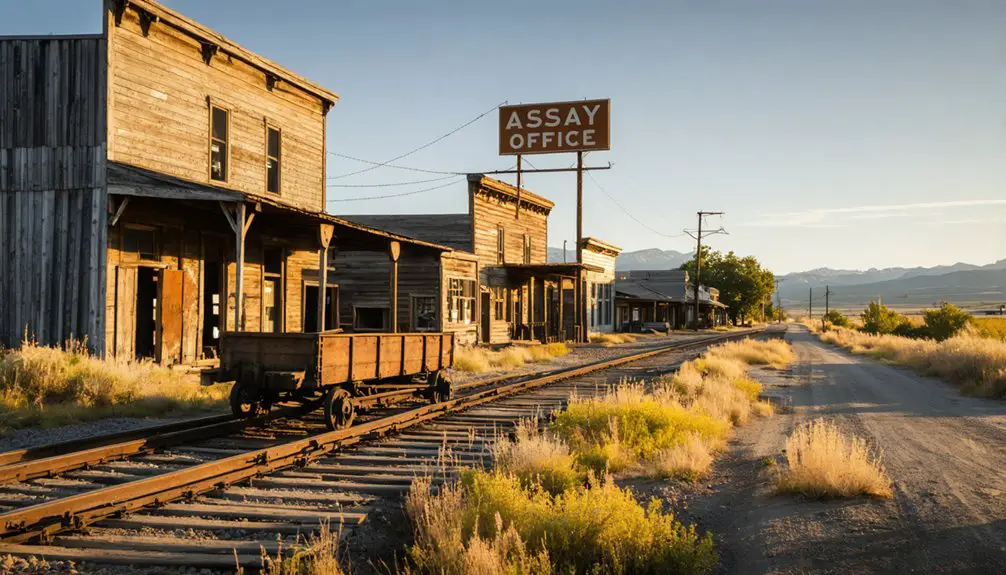
The promise of gold drew settlers to Red Bluff in 1864, establishing a vital outpost along Montana’s historic Bozeman Road.
Gold fever sparked Red Bluff’s birth in 1864, transforming a wilderness stop on the Bozeman Road into Montana’s newest frontier settlement.
You’d have found pioneers facing frontier challenges as they carved out a settlement in the rugged Tobacco Root Mountains, where mining techniques focused on extracting precious gold from the mineral-rich terrain.
At elevations between 4,900 and 5,600 feet, the town quickly grew to support nearly 500 residents.
Two gold mills powered the local economy, while essential businesses sprouted up to serve the mining community.
The bustling stage station stop became a crucial rest point for weary travelers along the Bozeman Road.
You could’ve witnessed the town’s rapid development as stores, a post office, and twelve saloons transformed this strategic location into a bustling hub for travelers and miners pushing deeper into Montana’s untamed interior.
Gold Rush Glory Days
During Red Bluff’s golden heyday of the 1860s, you’d have witnessed a bustling frontier economy driven by two industrial gold mills processing ore from the region’s rich mineral deposits.
Gold mining attracted a transient population of fortune seekers who brought life to this Montana boomtown, swelling its numbers to around 500 residents. Like many mining towns of the era, Red Bluff drew prospectors who arrived via the Missouri River route to seek their fortunes.
You’d have found miners using both traditional panning methods and advanced placer mining techniques in the surrounding creeks, occasionally unearthing impressive nuggets weighing up to 4.5 ounces.
The town’s dozen saloons served as gathering spots for weary prospectors, while a post office and school provided essential services.
This prosperity wouldn’t last forever though – by 1890, when the railroad chose nearby Norris as its hub, Red Bluff’s glory days began fading into history.
Life in 19th Century Red Bluff
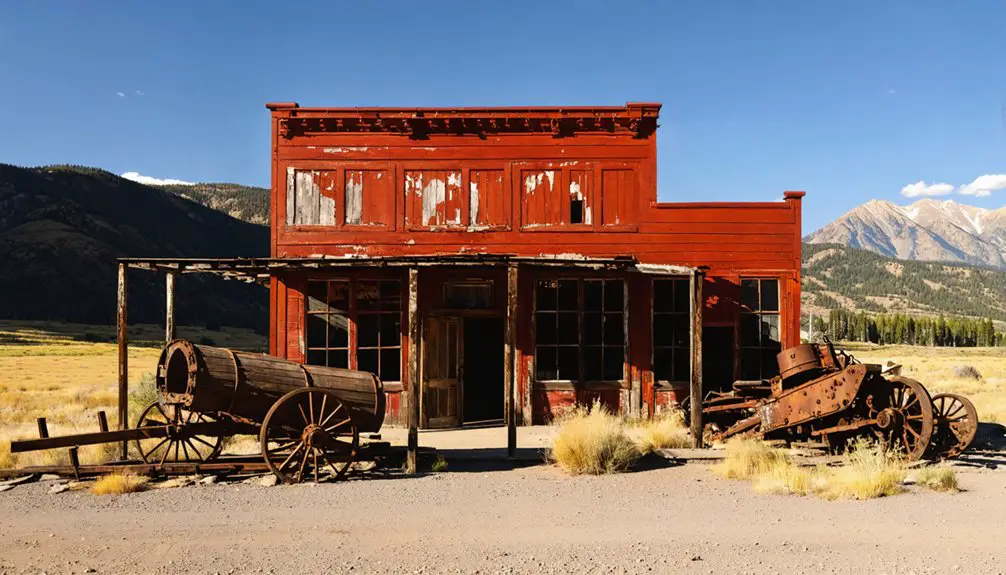
If you’d visited Red Bluff during its heyday, you’d have found yourself among 500 residents bustling between two gold mills, where miners weighed gold dust for their daily transactions.
You could’ve grabbed a drink at any of the 12 saloons that lined the streets alongside essential services like the post office and schoolhouse.
Your daily routines would’ve centered around the Bozeman Road stagecoach stop, where travelers, miners, and townspeople merged into a vibrant social scene typical of Montana’s 19th-century mining communities.
Like many Montana settlements that emerged after the Louisiana Purchase in 1803, Red Bluff developed as pioneers pushed westward into the newly acquired territory.
Daily Mining Town Activities
Life in Red Bluff centered around three primary daily activities: mining operations in the Tobacco Root Mountains, domestic responsibilities at home, and community engagement through education and trade.
You’d find miners wielding pickaxes and shovels in the gold-rich hills, employing basic mining techniques to extract precious ore that’d be processed at two local mills.
While men labored in the mines, family dynamics revolved around women managing households and children helping with chores. Kids split their time between the small stone schoolhouse and home duties, often creating their own entertainment with improvised toys.
The town’s economy operated on a mix of cash, barter, and credit, with crucial supplies arriving via lengthy supply chains from Bozeman.
Local blacksmiths kept mining tools repaired, while the post office served as a crucial communication hub until 1901.
Business and Entertainment Scene
Red Bluff’s vibrant business and entertainment scene revolved around its twelve bustling saloons, which served as the town’s primary social hubs in the late 1800s. You’d find miners and merchants striking deals, playing cards, and sharing news over drinks while occasional live music filled the air.
Local commerce thrived through establishments like S.R. Buford and Company, supplying goods to both the mining community and surrounding ranches.
Beyond the saloons culture, you could find lodging at the Tanners Hotel, send mail at the post office, or catch a stagecoach to Virginia City. The town’s school served as a gathering place for community events, while various merchants provided essential services.
Agricultural trade and freight contracts kept the town’s economy diverse, connecting Red Bluff to the wider region despite its modest population of 500 residents.
Community Infrastructure Development
During its prime in the 1860s and 1870s, you’d find Red Bluff’s infrastructure rapidly expanding around its strategic position on the Bozeman Road. The town developed essential services to support its growing population of miners and settlers, fostering strong community engagement through shared spaces and facilities.
Key infrastructure developments included:
- A central post office that served as the town’s communication hub for mail and news
- A stone schoolhouse south of the highway that provided education for local children
- Two gold mills within town limits that processed ore from nearby mountain mines
- The Tanners Hotel, which offered lodging and served as a social gathering place
This infrastructure supported Red Bluff’s peak population of 500 until the 1890s, when the railroad’s bypass triggered the community’s decline.
Economic Peak and Population Growth
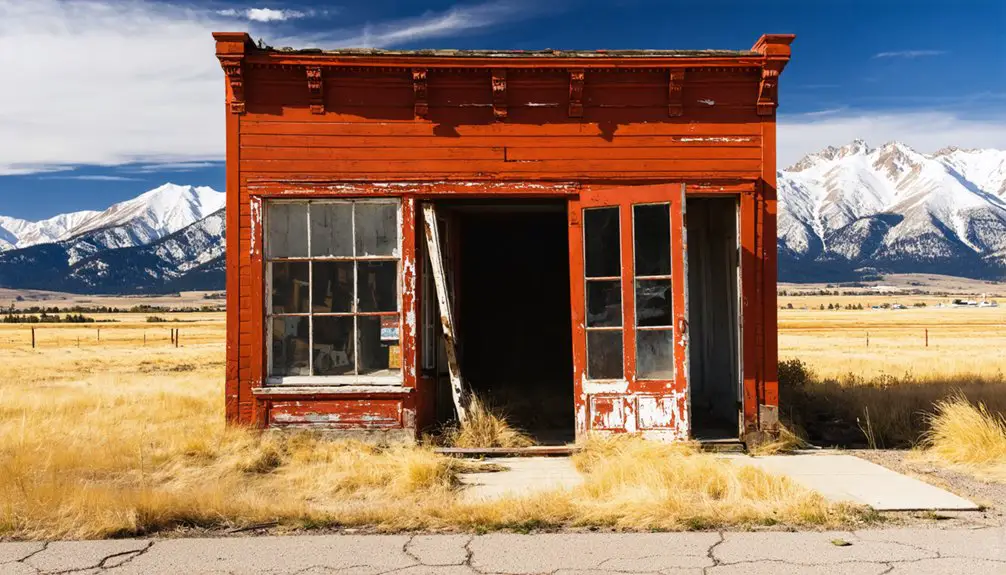
You’ll find Red Bluff’s economic prosperity was built on its two bustling gold mills and the rich mineral deposits in the nearby Tobacco Root Mountains.
Similar to the gold rush at Grasshopper Creek, Red Bluff drew many prospectors seeking their fortunes in Montana Territory.
The town’s strategic location along the Bozeman Road helped it grow into a thriving community of 500 residents, complete with a post office, school, and at least twelve saloons serving the local miners and travelers.
Local businesses flourished during the late 1800s as Red Bluff established itself as a key hub in Montana’s mining industry, supporting both the extraction operations and the steady stream of fortune-seekers passing through.
Like many of Montana’s precious ore deposits, the town’s mining operations yielded millions of dollars in valuable minerals during its peak years.
Mining Sparks Town Growth
The discovery of coal and precious metals in Montana sparked a dramatic transformation of Red Bluff from a sparse settlement into a bustling mining town. As word spread of the region’s rich deposits, mining migration brought workers from diverse backgrounds, establishing a thriving coal company town centered around underground operations.
You’ll find these remarkable changes reflected in Red Bluff’s explosive growth:
- Population surged from 624 residents in 1890 to 4,860 by 1910
- Mining companies built worker housing and essential community facilities
- Coal processing plants and transportation infrastructure rapidly developed
- Workforce diversity expanded as Chinese miners and other ethnic groups settled in the area
This industrial boom created hundreds of jobs while supporting ancillary businesses, transforming Red Bluff into a crucial hub of Montana’s mining economy.
Peak Business Operations
As Red Bluff reached its economic zenith between 1910-1915, the town’s population swelled to 4,860 residents, marking an era of unprecedented prosperity.
You’d have witnessed explosive growth rates exceeding 100% each decade, with a staggering 244.9% surge in 1900 alone. Mining technology drove the town’s success, creating numerous jobs and attracting workers from across the region.
The boom wouldn’t last forever, though. By the 1920s, the population dropped 7%, followed by a steeper 33% decline in the 1930s.
Economic diversification became essential as the town transformed. Agriculture and ranching emerged as critical industries, while tourism, outdoor recreation, and professional services now sustain Red Bluff’s smaller but more stable modern economy of around 2,000 residents.
Transportation and Trade Routes
During Red Bluff’s formative years, stagecoaches rumbled along the Bozeman Road, establishing the town’s crucial role as a stage station from 1864 onward.
Stagecoach wheels carved history into Red Bluff’s soul, as the Bozeman Road transformed this humble stop into a vital frontier hub.
You’ll find evidence of these historic trade dynamics in the deep cuts through hillsides and coulees, where stage roads carved permanent paths into the landscape. The transportation evolution near Red Bluff shaped the region’s development, connecting essential mining operations in the Tobacco Root Mountains to larger market centers.
Key transportation features included:
- Taverns positioned every 20 miles for rest stops and horse changes
- Wagon routes hauling mining supplies and precious metals
- Winter-adapted travel with thermal protection against harsh conditions
- Early automobile routes following former stage roads, eventually complementing rail service
The Railroad’s Impact on Red Bluff
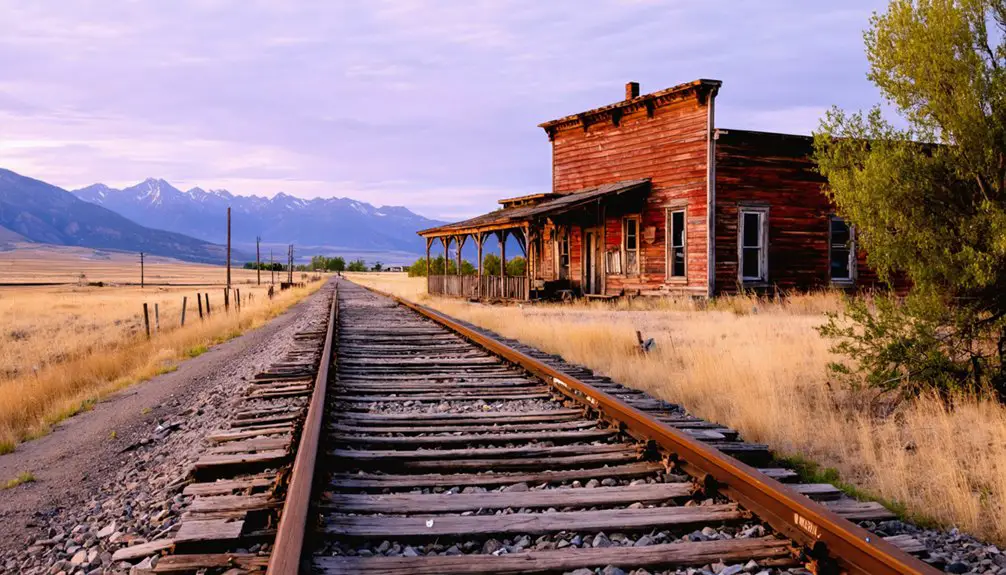
While Red Bluff prospered as a stagecoach stop through the 1880s, Northern Pacific Railroad‘s arrival in 1890 spelled doom for the once-thriving settlement.
The railroad’s decision to bypass Red Bluff and instead establish tracks near Alex Norris Ranch, about three miles west, triggered devastating urban decline.
You’ll find that this routing choice led to the creation of Norris town, which quickly siphoned away Red Bluff’s residents and businesses.
The railroad consequences were swift and absolute – by 1901, Red Bluff’s post office, school, and all commercial establishments had shut down.
Like many Montana frontier towns that didn’t secure rail access, Red Bluff couldn’t compete with rail-connected communities for moving mining resources and goods to market.
The rough terrain of Montana presented significant challenges for railroad construction, often forcing routes through more favorable locations.
Similar to Frank Hall’s failed vision for the Yellowstone Park Railroad, many Montana towns saw their dreams of prosperity vanish when rail lines chose alternate routes.
From Prosperity to Abandonment
Red Bluff’s journey from prosperity to abandonment began in 1864, when early settlers established the town as a mining hub and stage station along the Bozeman Road.
During its peak, you’d have found a bustling community of 500 residents thriving on gold mining in the nearby Tobacco Root Mountains. Following the gold discoveries elsewhere in Montana Territory during the 1860s, Red Bluff quickly emerged as another promising mining settlement. Like the modern ghost town of Saint Marie, Montana’s landscape is dotted with remnants of once-thriving communities.
- The town supported two gold mills, twelve saloons, and various businesses that served the mining operations.
- Essential infrastructure included a post office and school, showing Red Bluff’s commitment to permanent settlement.
- Economic decline struck in 1890 when the Northern Pacific Railroad bypassed Red Bluff for Norris.
- By 1901, this once-prosperous mining town had transformed into a ghost town as businesses, the post office, and school closed.
Today, you’ll find only ruins of Tanners Hotel and a stone schoolhouse marking Red Bluff’s former glory.
Preserved Remnants and Ruins Today
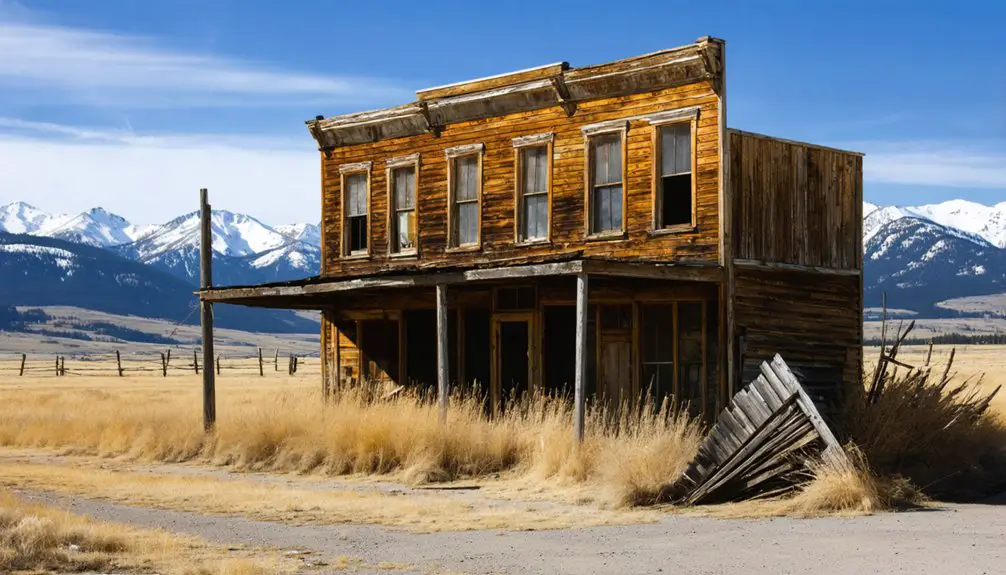
Modern visitors to Red Bluff will find a scattering of haunting remnants that tell the story of its mining-era glory.
You’ll discover the ruined stone walls of Tanners Hotel north of Highway 84, while the preserved remains of the town’s schoolhouse stand south of the road. The historic Red Bluff-Norris Cemetery lies northwest of the former townsite.
For a deeper look into the area’s mining heritage, you can explore the countless mining remnants in the nearby Tobacco Root Mountains. Like other Montana ghost towns that drew thousands of prospectors, these sites highlight the dramatic population swings that characterized frontier mining communities.
You’ll encounter abandoned shafts, processing sites, and tailings piles that showcase the region’s industrial past. While there’s no formal preservation infrastructure, these ruins hold significant historical value, offering glimpses into Montana’s 19th-century mining boom and the daily lives of its pioneer residents.
Red Bluff’s Legacy in Montana History
As one of Montana’s most emblematic gold rush settlements, Red Bluff stands as a tribute to the dramatic economic shifts that shaped Madison County’s development in the late 1800s.
You’ll find its legacy deeply woven into Montana’s mining heritage, reflecting the region’s cultural practices and dynamic community spirit during the gold rush era.
Red Bluff’s historical significance is preserved through:
- Its representation of boom-and-bust cycles that defined Montana’s mining communities
- The diverse social fabric that included miners, merchants, and families shaping frontier life
- Its role as a crucial hub along the Bozeman Road before railroad development
- The remaining physical evidence of mining operations and community infrastructure
Today, Red Bluff serves as a powerful reminder of how transportation changes and economic forces transformed Montana’s mining landscape forever.
Frequently Asked Questions
Are There Any Reported Paranormal Activities or Ghost Sightings in Red Bluff?
You won’t find documented ghost encounters or official paranormal investigations in Red Bluff. Unlike other Montana ghost towns like Bannack, this site lacks credible reports of supernatural activity.
What Happened to the Families Who Lived in Red Bluff After Abandonment?
You’ll find that most families relocated to Norris, following the railroad’s economic promise. They faced community struggles shifting from mining work, while their family legacies lived on through cemetery records and local histories.
Can Visitors Legally Collect Artifacts From the Red Bluff Site Today?
One person’s treasure is another’s legal trouble – you can’t collect artifacts from the site. Artifact preservation laws and historic protection regulations make removing items illegal, with potential fines and prosecution.
Were There Any Notable Crimes or Lawlessness During Red Bluff’s Peak Years?
While you’ll find evidence of typical frontier disorder around the town’s 12 saloons, Red Bluff’s documented crime history is surprisingly sparse, with no major recorded incidents requiring serious law enforcement intervention.
What Native American Tribes Originally Inhabited the Red Bluff Area?
You’ll find the Crow (Apsaalooke) were the primary Native American inhabitants, though Blackfoot Confederacy tribes also influenced the area’s cultural heritage through their seasonal hunting territories and migrations.
References
- https://www.legendsofamerica.com/red-bluff-montana/
- https://www.youtube.com/watch?v=8DRaKMLZvcs
- https://www.legendsofamerica.com/mt-ghosttowns/
- https://westernmininghistory.com/mine-detail/10107927/
- http://www.distinctlymontana.com/curious-afterlife-montanas-ghost-towns
- https://www.achp.gov/preserve-america/community/red-lodge-montana
- https://westernmininghistory.com/mine-detail/10294643/
- https://agresearch.montana.edu/campusfarms/redbluff.html
- https://mhs.mt.gov/education/textbook/chapter6/Chapter6.pdf
- https://discoveringmontana.com/history-of-the-gold-rush/
